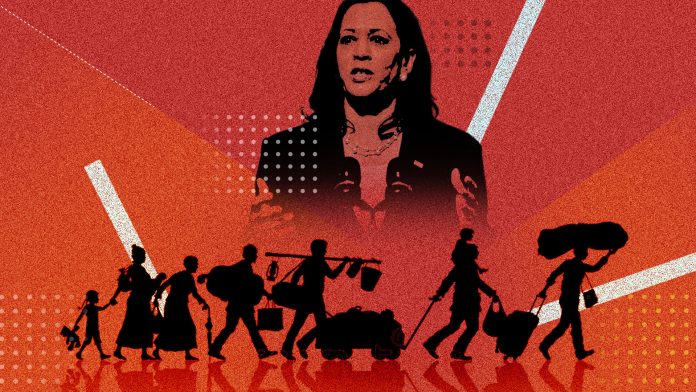
By Grisha Vera, editor at CONNECTAS
“God’s time is perfect and his work is wonderful. We did it, we made it. Now it’s up to the American authorities.” Says Pamelita Torrealba in a video on her Tik Tok profile. The Venezuelan, who left Chile on May 10th, has been sharing parts of her journey in short videos she posts on social media. After many mishaps, she arrived in Mexico on June 5th, and days later she was part of the third caravan that departed from the border with Guatemala, from Tapachula, in the south of the country,
Precisely on that day, the 9th Summit of the Americas kicked off in Los Angeles, United States. It came to an end on June 11th, with, among others, a continental agreement to increase attention and protection to migrants.
Commitments by the attendee States in the “Los Angeles Declaration on Migration and Protection” are grouped in four pillars. In the first, the United States foresees increasing migrant assistance funds by 339 million dollars, while Ecuador, Costa Rica, Colombia and Belize commit to regulating illegal migrants living in these countries. The second pillar aims at broadening legal and protection means, contemplating among others, family reunification of Haitians and Cubans. On the other hand, the United States and Canada are pledging to take in a larger number of refugees and migrant workers. The third pillar refers to the commitment of intensifying the safety of the population in transit and to ease the request of asylum in the United States border. The latter foresees a coordinated response in case of emergency.
México caravana
Aumenta número de migrantes rumbo EE.UU pic.twitter.com/F8cMJFlkUb— ITSMANIA PLATERO (@ItsmaniaP) June 9, 2022
More of the same? Honduran sociologist Ricardo Puerta, who has been researching migration topics since 1972, believes that none of the things that have been agreed are really new, but he considers that the intention to integrate the measures is positive. “They are looking for an effect that is multiple, not excluding. For instance, temporary migrants won’t be avoided, nor will private or public investment, which continues. it will be part of a package that didn’t exist before,” he says.
However, Itsmania Platero, also from Honduras and a journalist and advocate of migrants’ human rights, indicates that measures such as these have not had the desired effect. “The current migratory effect would not exist if there had been results.”
And that is how it is. An article published by Erika Mouynes, Minister of Foreign Affairs fo Panama, and Meghan Lopez, Regional Vice-President for Latin America of Comite Internacional de Rescate, explains that the amount of people that crossed the Darien Gap went from 6,500 in 2020 to 124,875 in the first eleven months of 2021.
@liodecuba Responder a @yesi_garcia97 #estadosunidos #estadosunidostiktok #estadosunidos🇺🇸 #cubanosporelmundo #selvadarien #selvadeldarien #cubanosenmiami #cubanostiktok #cubanos #cubano #cubana #cuba #patriayvida #soscuba #cubaesunadictadura #elcambioesya #latinos #latinosenusa #inmigrantes #inmigrantesenusa #migrantesenusa #liodecuba #inmigracionusa #migracionusa #cubanosenusa #inmigrante #migrantes #migrante #sueñoamericano ♬ sonido original – Lionel Baquero
Platero warns that the situation will carry on because the measures are not aimed at addressing the main causes of migration. For her, these measures are even contradictory. “On the one hand, they are selling the idea that (illegal migration) is bad, and on the other, they are saying that opportunities are going to be available. Yet, that is not the case. People are failing to understand the message that it is actually dangerous.”
Pertaining to that concern, at the beginning of the Summit, Kamala Harris, Vice-President of the United States, announced on Tuesday, June 7th, a plan by which ten large American companies will invest 1.2 billion dollars to generate employment in the countries of the Northern Triangle of Central America. It is not a new measure either: in 2021 it had been announced that thirty companies would invest a total amount of 2 billion dollars for that same purpose.
New or not, the measures proposed clash with an indisputable reality: a dialogue of the deaf. Indeed, as a result of ideological differences or of other kinds, none of the presidents of the countries of the Northern Triangle (Guatemala, Honduras and El Salvador) attended the Summit. This fact evinced the lack of political will by these governments, a factor that is indispensable to tackle the structural causes of migration. These three countries not only expel migrants, but are also transit nations through which the population of South American migrants circulates en route to the United States.
Adam Isacson, expert in migration in the southern border at the Washington Office on Latin America (WOLA) said on the matter to CNN en Español: “It is a shame that none of the governments are there to discuss the topic, mostly Honduras, but in general, the current governments of the Northern Triangle act more as hurdles than as partners.”
Certainly, more than a problem, migration is an opportunity for the United States. Indeed, a large part of its income comes from remittances that migrants in the United States send to their families back home. The figures are impressive: in 2020, according to data from the World Bank, Guatemala received 11.4 billion dollars (14.8% of its GDP), Honduras 5.5 billion dollars (23.5% of its GDP) and El Salvador 5.9 billion (24.1% of its GDP).
The lack of will of countries that benefit from this initiative may cripple these communities’ economic and social development. As Puerta analyzes, “a huge part of the effort taking place is not just offering money but generating the capacity to interact with binational interconnectivity. The intention now, unlike with other schemes, is to attain the impact of codevelopment. Meaning, the business development of the community of origin and the business development of the receiving countries.”
Insufficient
Certainly, the measures vow to address several fronts of the phenomenon of migration in the area. Yet it is not a comprehensive nor exhaustive response: sociologist Puerta explains that a program of this magnitude would require a multi-million investment in order to be successful.
Only in that way could a comprehensive policy address all of the causes of migration in countries that expel migrants and in countries of transit, as of now, that has not been foreseen. “What will happen with investment and training in countries in the Central American region? It will become a sanctuary. but that won’t decrease migration because people will always pass through here,” Platero asserts.
On the other hand, the initiative announced by Vice-President Harris is based on employment generation, connectivity and training. However, the measure focuses on women, girls and young people in Central America. For Platero, this approach “is a bit selective and discriminatory, because it only targets young people and women. Although the migrating population also includes people over 40, because people of that age have difficulties working in this country.”
@nestyacostaa #injusticia #viraltiktok #viralvideo #viral #chiapas #tapachula #mexico #emigrantes esto es algo sin sentido no se cual es la película que se inventa el #gobiernodemexico ♬ sonido original – Nesty Acosta
Unaccompanied migrant children constitute another situation that has been overlooked. Platero questions it: “Children’s protection is not contemplated, and children don’t work, so what are children going to do in the United States?”
But there is an underlying factor that is equally devastating, the divorce between the prevailing measures thus far and the economic and social reality: Puerta points at employment demand in the north as a necessary factor to understand the migratory flux in the continent. “If the United States fails to attract a million immigrants within a year, most of its employment will be unfulfilled. Structurally, the North American economy needs migration”. Illegal migrants know this and they face all sorts of dangers to take advantage of this reality.



